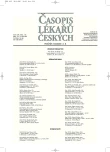Juvenile Hyperbilirubinaemia and Its Early Manifestation in Adolescence
Authors:
P. Kabíček 1,2; L. Barnincová 1
Authors‘ workplace:
Klinika dětského a dorostového lékařství 1. LF UK a VFN, Praha
1; Subkatedra dorostového lékařství IPVZ, Praha
2
Published in:
Čas. Lék. čes. 2007; 146: 528-532
Category:
Review Article
Overview
Mild isolated unconjugated hyperbilirubinaemia is incidentally or purposefully attained finding in 4–8 % of population. Adolescence is a typical age for detection of hypebilirubinaemia. In these patients a mutation in gene-promoter for uridin-diphospho-glucuronyl-transpherase A 1, which determines development of the benign Gilbert’s syndrome, is present in most of the cases. Although homozygote formation of this mutation was described in 11–16 % of general population, only in a part of them hyperbilirubinaemia is manifested. Beginning or continuation of hyperbilirubinaemia in adolescent age is linked probably with some other changes in the hepatocyte and factors which influence it. Among adolescents with hyperbilirubinaemia, risk factors that can induce a metabolic liver overload have to be considered. They include oligosymptomatic or asymptomatic EBV infection, drug and alcohol abuse,hormonal contraception etc. These conditions must be respected in the regimen of these adolescents.
Key words:
Gilbert’s syndrome, hyperbilirubinaemia, EBV infection, infectious mononucleosis, adolescence.
Labels
Addictology Allergology and clinical immunology Angiology Audiology Clinical biochemistry Dermatology & STDs Paediatric gastroenterology Paediatric surgery Paediatric cardiology Paediatric neurology Paediatric ENT Paediatric psychiatry Paediatric rheumatology Diabetology Pharmacy Vascular surgery Pain management Dental HygienistArticle was published in
Journal of Czech Physicians

Most read in this issue
- Surgery Tracheostomies and Percutaneous Dilatation Tracheostomies – Retrospective Study
- Juvenile Hyperbilirubinaemia and Its Early Manifestation in Adolescence
- Can Modern Infusion Solutions Cause Serious Disruption of Inner Environment of an Organism?
- Abdominal Tuberculosis in CT Imaging
